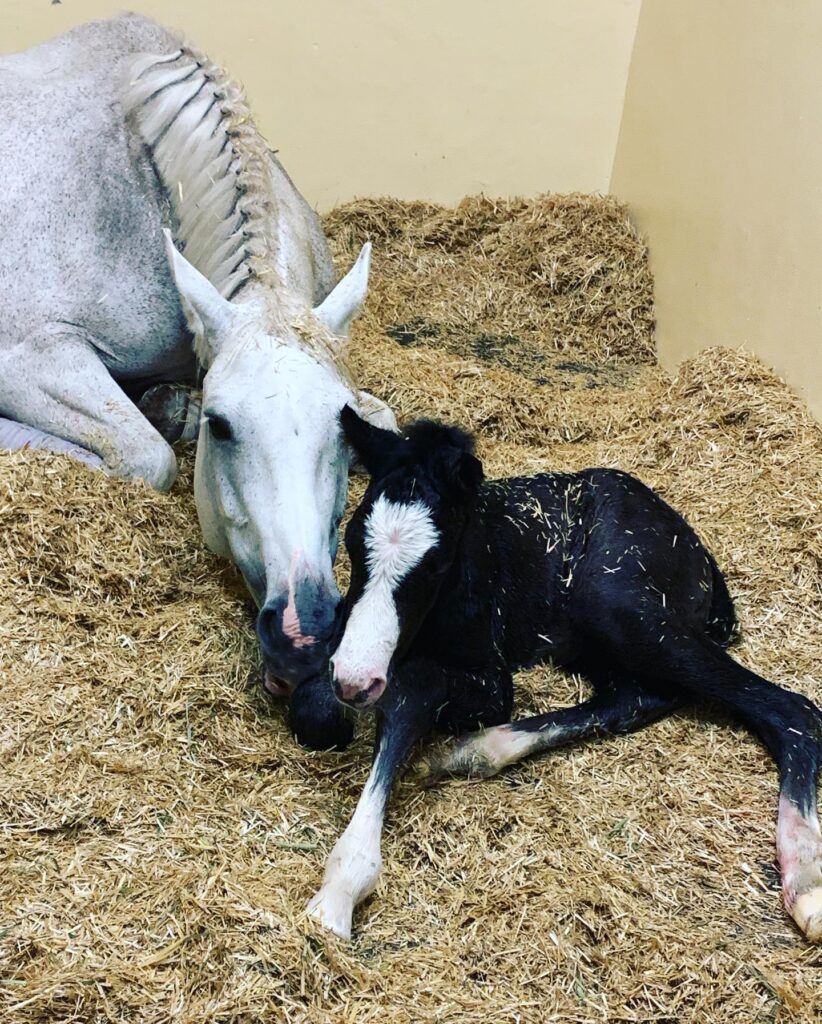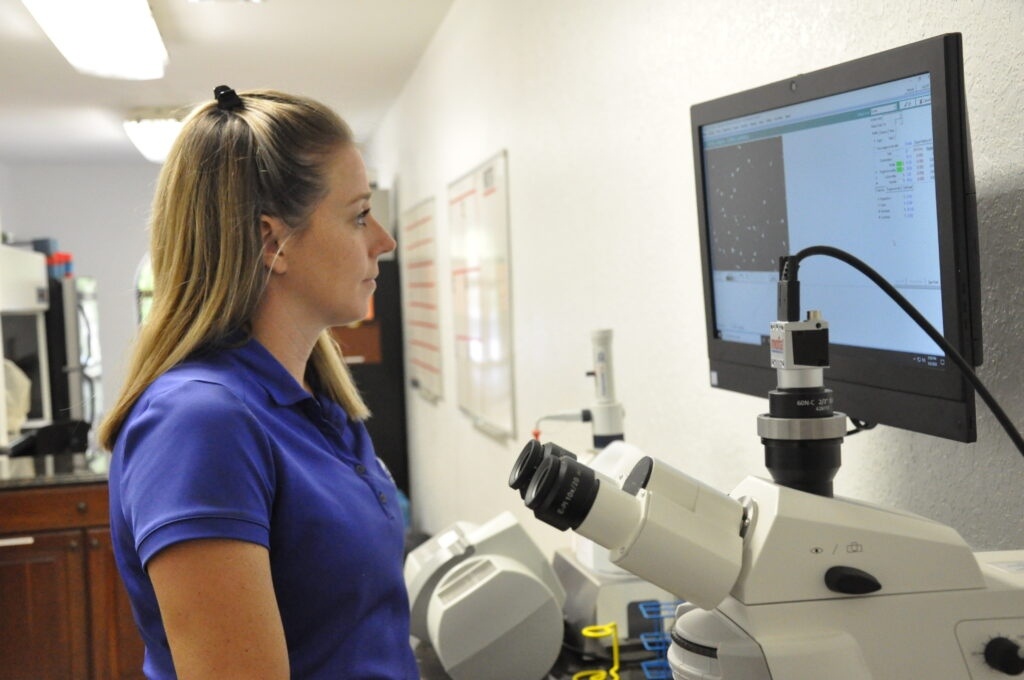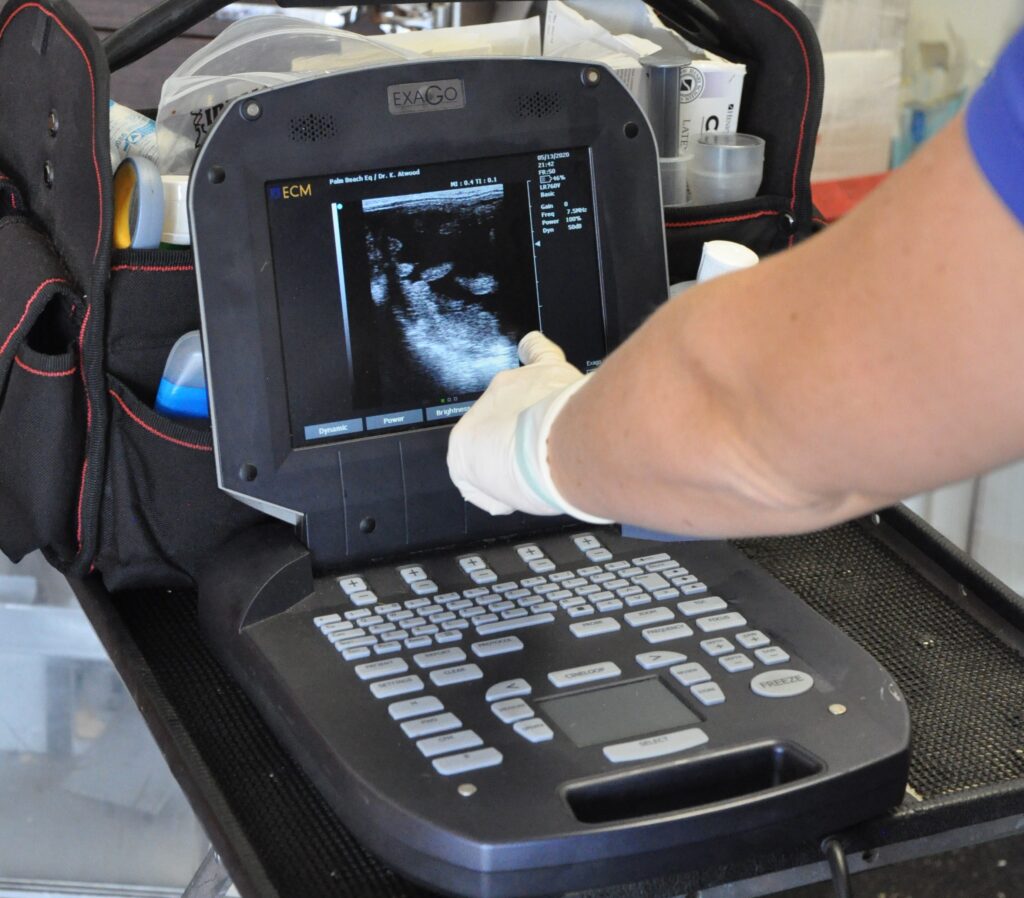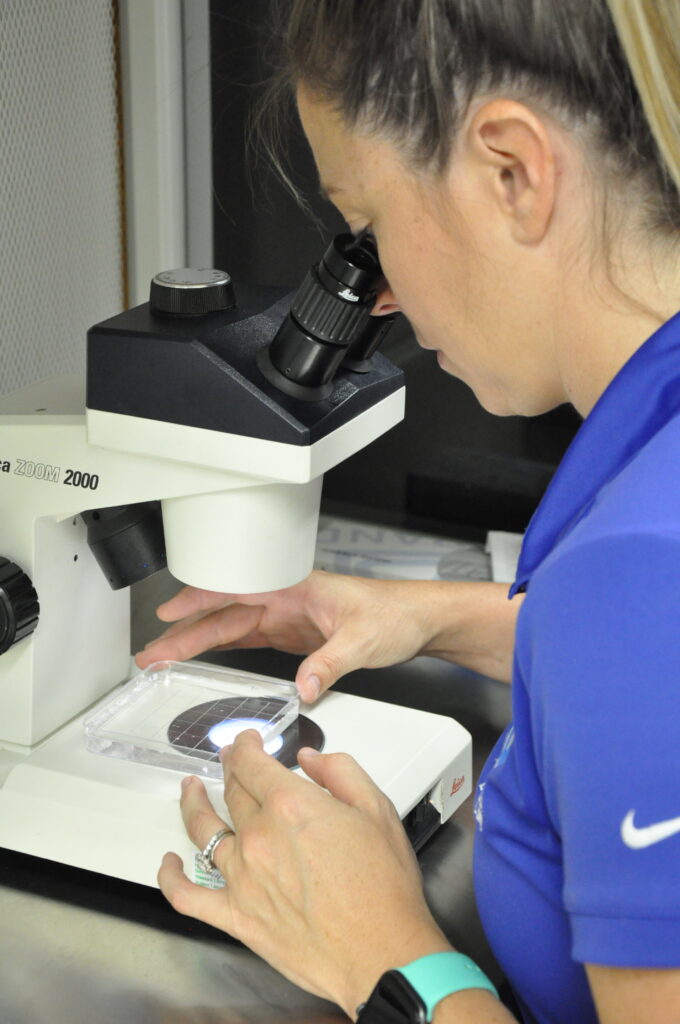Month: March 2021
On March 24, 2021, board-certified internal medicine specialist Dr. Peter Heidmann answered questions regarding Equine Herpesvirus (EHV) live on the Noelle Floyd Instagram page. Watch the video below or read these six main takeaways he discussed.
1. Equine Herpesvirus (EHV) can be present in any area where there are horses.
EHV can be found in horses in every country around the world. The virus can have varying consequences and not every horse may be symptomatic. The duration of their immunity, their capability to shed viral particles, and whether they continue to carry the virus are all variables unique to the individual horse.
2. There are multiple strains of EHV that lead to varying health defects.
Most horses, by two years old, have been exposed to EHV. Nearly every horse over five years old has had EHV in a mild respiratory form, in which they have likely suffered from symptoms such as a runny nose or cough. The disease becomes gravely serious when there is a neurological form of EHV-1 that is spreading rapidly among horses.
Over the last century, the primary focus of EHV disease control was related to reproduction. EHV was a major cause of infectious abortions in mares. Since the advent of effective vaccines that protect against EHV abortions, the concern has shifted to the rare but serious occurrences of neurologic disease caused by EHV-1.
Certain strains of EHV can have more propensity to cause neurological disease, while others do not. It is important to understand that both “neurologic” and “non-neurologic” strains can cause neuro symptoms, and that some horses infected with “non-neurologic” strains may also develop the neurologic form of the disease. Symptoms of mild neurologic disease can include ataxia or hind end weakness and irregular gaits. When horses suffer mild neurologic symptoms, most will make a full recovery. If they suffer from severe symptoms, it can be increasingly difficult to treat, and some cases can be fatal.
3. Vaccination is key.
There are currently no genetic explanations regarding whether a particular horse may be more likely to contract EHV-1. However, when a horse is stressed, whether it be from shipping, competing, or other causes, its immune system is more susceptible to illness. EHV-1 can live in the central nervous system, and during times of stress when endogenous corticoids are produced, the virus can start to replicate. This causes the horse to shed viral particles into the environment and explains why there are outbreaks of the disease. It does not take much for a stressed horse to start shedding viral particles into the environment and infecting non-stressed horses nearby.
Vaccinations can help horses generate additional antibodies and minimize the spread of disease. The vaccines available today are effective at preventing the respiratory and reproductive strains of EHV, but are not effective for the neurologic strain. It is just as important as ever to vaccinate because vaccines help to limit the spread of virus by decreasing the shedding of viral particles from each individual horse.
Immunization is recommended every six months at a minimum. Most vaccine manufacturers suggest vaccinating against EHV as often as once every 90 days when travelling or competing. It is recommended to work closely with your veterinarian to tailor a vaccination program for your horses’ specific requirements.

4. Surveillance is crucial to preventing a serious outbreak in the United States.
Due to the recent outbreak in Europe, medical surveillance has increased. There are now extra layers of protection in the process of importing horses. Imported horses have always been quarantined, but now horses are also receiving a nasal swab to look for the presence of EHV-1 in their nasal passages. There have been cases of EHV-1 in the U.S. recently. However, there is no evidence that these EHV-1 cases are related to the major outbreak in Europe, partially thanks to our increased level of surveillance on horses being brought into the country.
5. The handling of horses with fevers shifts dramatically when cases have been identified locally.
Veterinarians have significantly shifted how show horses with any symptoms are being handled. If a horse had presented with a fever or runny nose prior to the European EHV-1 outbreak in early 2021, it would typically have been treated by its own veterinarian and left to return to full health. What is happening now is that each horse with a fever becomes a possible candidate for being the index case of EHV-1. This changes veterinarians’ responsibilities everywhere because of the potential for the disease to spread among the population in respective local areas. Horses with fevers must therefore be strictly quarantined and tested.
The fastest and most accurate test in the world for diagnosing EHV-1 is a PCR test, which looks for the DNA of the infecting organism. The horse will test positive if it is actively shedding organisms. The biggest downside is that it typically takes 24 hours to produce results. Therefore, horses who have been tested are put under strict isolation until the test results come back. Often, by the time test results are ready, the horse’s symptoms have ceased. Yet that is the level of scrutiny necessary to prevent a serious outbreak.

6. There are clusters of the disease reported all over the Unites States, although they are unrelated to the neurological strain of EHV-1 outbreak in Europe.
While this is routine from a veterinarian’s perspective, it is still serious and certainly worth our attention. A few isolated cases reported in the U.S. this March have been found to be due to the neurotropic form of the disease and some have been non-neurotropic. The concern is warranted, but cases are highly localized, mainly in areas with large equine populations. We see the disease cropping up because the virus may already be dormant in their bodies. To minimize the likelihood of outbreaks on the individual farm level, have a vaccination program with your veterinarian and if necessary take temperatures of horses twice daily to catch any viral infection early.
For up-to-date information on reported cases of EHV, horse owners can utilize the following resources:
- Disease outbreak alerts via the Equine Disease Communication Center
- FEI website for notices and updates on international competition protocols
- Your state’s Department of Agriculture website for reportable diseases in your area
Considerations for Breeding the Sport Horse Mare

Breeding is not typically on the forefront of owners’ minds when it comes to their high-performance sport horse mare. The focus is mostly on keeping those mares at their best, in terms of health, athleticism, and performance. Prospects for them being bred are usually reserved for well after their competition schedule winds down.
Often when sport horse mares are injured and their careers are either put on hold or cut short altogether, breeding may become the next best option for the owner to consider. Depending on the injury sustained and their overall health and age, breeding can be a great alternative for the out-of-work mare. However, modern reproduction techniques have made breeding the sport horse mare not only an option reserved for after their careers have come to a close. Through embryo transfer, mares can produce multiple foals during the same season all while continuing their training and competition schedules.
With the possibility of breeding comes a significant number of unknowns, so we asked Palm Beach Equine Clinic veterinarian Dr. Katie Atwood to guide us through the process of examining a mares’ reproductive health and the different options for creating a foal.
Start with a vision for the future foal
The first step when embarking on the breeding process is to choose the stallion. This decision hinges entirely on what the owner’s vision and end goal may be for the future foal.
“The owner will need to know what they want that future foal’s purpose to be before choosing a stallion,” Dr. Atwood explained. “Owners should already be in the process of choosing a stallion or have already decided before examining the mare.”

“There are countless breeding stallions across all different breeds and disciplines, and it all comes down to the owner’s opinion and preferences. If I have personally met the stallion, I can comment on their disposition, but I do not make recommendations on one stallion versus another. As the veterinarian, I pay attention to their health and fertility versus the external qualities that do not play a role in reproduction. I let the professionals – owners, riders, and trainers – make those decisions,” said Dr. Atwood.
Evaluating the mare’s reproductive soundness
After assessing the mare’s overall health and taking into account her breeding history, Dr. Atwood will begin with the reproductive soundness exam. This usually includes a rectal ultrasound and palpation of the uterus, ovaries, and cervix. Dr. Atwood also typically performs a vaginal speculum exam to examine the quality of the mare’s cervix. All the information that Dr. Atwood gathers during this step helps to determine what stage the mare is at in her estrous cycle, identify any potential issues, and establish the next steps.
“When performing that first ultrasound, I look for endometrial cysts, fluid or air, and mucus in the uterus,” said Dr. Atwood. “I examine both ovaries to make sure they appear normal and are cycling normally. There are a lot of elements that can change depending on the time of year and where the mare may be in her cycle. But if we are examining her during breeding season, then I can evaluate whether or not there are any abnormalities.”
During the ultrasound, Dr. Atwood will look for signs of Endometritis, an inflammation and infection of the most superficial layer of the uterus and a big reason why mares can’t get pregnant. It is important to identify issues such as this before taking any further steps.


Age can bring about changes to the uterus, as can any previous pregnancies, so a uterine biopsy is also recommended for older mares (generally over 14 years old) before being bred. Some of those changes, such as fibrosis, are irreversible, which is also crucial to know before you proceed further with breeding.
Maiden mares can also have their own challenges if being bred for the first time at a later stage in their life. “When a middle-aged or older mare has not had a foal before, her cervix does not relax. This means that they more easily maintain fluid in their uterus and that can present its own complications,” commented Dr. Atwood. Dr. Atwood also notes that the conformation of the mare’s external genitalia needs to be taken into consideration. If the mare’s anatomy predisposes her to uterine infections, there will likely be complications throughout the pregnancy.
Getting the timing right
Since many sport horses will travel frequently over far distances and through different climates, its important to consider the mare’s natural estrous cycle and her best time for ovulation. “Here in south Florida, a lot of clients will want to breed their horse when they arrive for the winter season,” said Dr. Atwood. “Their mare may have been in New York for the last 8 months, so her uterus is still influx with New York seasons and she is anestrous, meaning that she is not cycling.”
When the mare is in her seasonal anestrous, her uterus is flaccid and her ovaries are not producing follicles. The veterinarian can administer a hormonal therapy to help trigger ovulation, however, Dr. Atwood tries to go the natural route whenever possible. In these situations where the owner wants to breed the mare and are traveling from up north, Dr. Atwood has a simple yet effective trick.
“I usually recommend putting the mare under lights starting in the beginning of December and lasting until they are bred. This is a very simple, economic way we can naturally stimulate the mare to cycle. The mare only needs to be under lights from 4 p.m. until 11 p.m. and the brightness test is that you’ll need to be able to read a newspaper in the darkest corner of the stall,” said Dr. Atwood.

Considering a surrogate mare
Using a surrogate mare is one of the most popular routes for breeding sport horse mares. This process requires an embryo transfer, meaning that an embryo from the donor mare will be transferred to a surrogate, or recipient, mare to carry the foal to term. Embryo transfer has become a leading method for breeding as it relieves many of the owner’s concerns regarding the mare’s health and carrying the foal. It also allows the mare to be bred at an ideal reproductive age without any interruptions to their training and competition schedules.
“The average gestation period for a horse is 11 months and you’re only producing one foal per year with traditional breeding. Embryo transfer allows the mare to produce multiple foals per year while remaining in their normal routine,” commented Dr. Atwood.
What the surrogate mare process entails
Dr. Atwood cautions that a one-to-one ratio is not a good plan for a surrogate mare. In other words, she advises that you do not choose one single mare you’d like to be the surrogate, but rather go through a commercial recipient herd.

“I advise clients to not just rely on another one of their mares as a surrogate,” said Dr. Atwood. “In a perfect world, I would line up three recipient mares for every donor mare. The donor and recipient mares have to be on the same cycle because if you are going to take an embryo out, you have to put it in a uterus that’s ready for that embryo.”
Though the deposit to reserve a mare in a commercial herd can be costly and often nonrefundable, it guarantees that there will be a mare in the herd on any given day that is ready to receive the embryo. When it comes time for the embryo transfer, the mare whose uterus is the best quality on that day will receive the embryo. Prior to the embryo transfer, the donor mare will still undergo an ultrasound and palpation exam to determine her reproductive health.
Genetically, the recipient mare has no contribution to the genetic makeup of the foal if breeding through embryo transfer. The foal will be with that recipient mare from birth to weanling (six months), so there is a possibility that some of her personality traits could rub off but that is often not the case. “The recipient mare is usually under the age of eight, an appropriate size, and has a nice, calm disposition,” commented Dr. Atwood. “Some owners do have the recipient mare shipped to their personal barn during the last stages of the pregnancy because they want to be part of the foaling process or have their own team and veterinarian there for that process.”
Speak with a veterinarian about your mare’s breeding options

If you are considering breeding your mare, keep in mind the time of year, whether you’d like to use a surrogate, and what you want the final result to be. The breeding process can be a bit overwhelming, especially for those who are new to it, but Palm Beach Equine Clinic veterinarians are here to assist and guide you in the process whenever help is needed. At the end of the day, for Dr. Atwood, the reproductive process is her passion, so she is always eager to meet new patients and help plan for a new foal.
“I love the creation of life,” Dr. Atwood remarked. “Equine medicine is intriguing, but you’re usually handling sick, unhealthy animals. With reproduction, I am working with healthy animals and making their babies, which I love.”
Contact the Palm Beach Equine Clinic Reproduction Department:
10:30 a.m. on March 4, 2021 – Equine Herpesvirus (EHV) is a highly infectious DNA virus found all over the world. Currently, there is an outbreak of the neurological form of EHV-1 in Europe, which originated in Spain. This has resulted in outbreaks in at least three other European countries and the cancellation of FEI competitions through the month of March.
EHV-1 is contagious and spread by direct horse-to-horse contact via the respiratory tract through nasal secretions or indirectly through surfaces that have been contaminated with the virus.
In Wellington, Florida, we currently have no reported cases of affected horses. Our location in the Winter Equestrian Capital of the World poses its own risk factors with large numbers of horses in close quarters and under the stresses of competition and travel. This heightens our shared responsibility to take specific measures that will help keep each horse safe from the virus. We can work towards this by implementing two strategies: biosecurity and vaccination protocols.
1. Biosecurity
Implementing thorough hygiene and biosecurity protocols is important at all times, even when an outbreak has not occurred. Biosecurity and preventing the spread of disease is fresh in our minds due to the COVID-19 pandemic, and owners must now implement specific protocols at their barns for the safety of their horses. Some biosecurity steps to prevent the spread of EHV-1 include:
- Limit direct contact of your horse with others whenever possible – think equine “social distancing.” Do not use communal water buckets and avoid mixing of horses wherever possible.
- Take your horse’s temperature twice daily and report any horse with a temperature above 101.5 degrees Fahrenheit to your veterinarian immediately.
- Pay close attention for signs of respiratory or neurological disease. Clinical signs of neurologic disease may include incoordination, hind limb weakness, lethargy, head tilt, inability to get up after laying down, and inability to maintain balance. Clinical signs of respiratory disease often include discharge from the nostrils or eyes or swelling in the throatlatch area.
- Do not share buckets, halters, leads, bridles, or other tack between horses to prevent possible cross contamination. Clearly label your equipment, and if you must share, make sure to scrub and thoroughly clean equipment with detergent before using with another horse.
- Prevent people in your barn from potentially transferring the virus by washing your hands between handling different horses. Bring a change of clothes and shoes incase a horse is suspected of being infected.
- If you suspect your horse may be infected or has a high temperature, immediately isolate them from the other horses at your barn and contact your veterinarian. Ideally, a potentially sick horse should be moved into a separate building or paddock, or to an isolation facility. Palm Beach Equine Clinic is equipped with a USDA-approved quarantine center and is readily available to initiate the laboratory diagnostics required for diagnosing EHV-1.

2. Vaccinate
Making sure your horse is up to date on all their vaccines will help strengthen their immune system against potential viruses. There are vaccines available to protect against the respiratory disease and abortion-causing EHV (Rhinopneumonitis vaccine), however, there is no vaccine available for protection against the neurologic form. Some EHV vaccines can reduce nasal shedding of the disease, therefore potentially reducing transmission. Please contact your veterinarian for any questions regarding vaccinating your horse.
What To Do Next
If you have recently imported a horse or are planning for the arrival of a horse from any country in mainland Europe, please take extra precaution by calling your veterinarian. In addition to implementing biosecurity measures in the barn, Palm Beach Equine Clinic veterinarians recommend that your imported horse receive a nasal swab and blood sample to detect the virus by PCR (polymerase chain reaction), which will identify the DNA of the virus.
EHV is a normally occurring virus in the equine population, but by following vaccination and biosecurity protocols, outbreaks can be minimized and contained. Early identification and reporting of the virus is key to tracing and preventing further spread. If you have any questions or concerns about your horse horse’s health, please contact Palm Beach Equine Clinic at 561-793-1599 to speak with a veterinarian.
